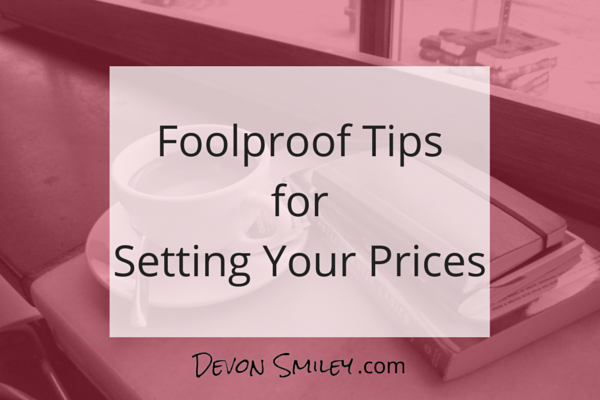
I see you over there. Plotting your Next Big Thing. Crafting a launch strategy. Gearing up to have a rate increase chat with your favourite client.
Excellent – You’re on the right path to business success and excitement! There’s just one question that remains.
What are you going to charge?
Set your prices too low and you’re working your buns off and barely scraping by. Set them too high and you’ll spend more time convincing yourself you’re worth it, than delivering A+ service to your clients.
It’s a fine balance. And figuring out what your prices are going to be – whether they’re your launch prices or new-and-improved price increases – can be a challenge. But it’s not impossible.
Here are my go-to strategies for setting a price that pays.
Market Research
Taking the pulse of what others in your industry are charging is a great way to determine your own prices, especially if you’re just starting out. Don’t forget – you can expand your research outside of your industry. Look for similarities in duration, client benefit and format of delivery, rather than matching content.
Example: You’re cooking up a 6-part ecourse on web design that’ll be a combo of email, video and FB group participation. Looking around the market, you’ve noticed that a lot of other courses are being priced between $75 and $200. (There’s your range) You know that people who follow your course will be able to convert more clients, and improve their earnings…and that you’re pouring a ton of work into creating the modules. $75 is too low…but $150 feels good. You’re in line with the market, but still respecting your effort and the value you’re delivering.
Cost Plus
Building up your price from the bottom up is a solid way to make sure that not only are your costs covered, but you turn a satisfactory profit. The key? Having a crystal clear view on all of the time and effort you’re putting into creating the product or service, so that nothing slips through the cracks.
Example: Everyone loves the knitted scarves you send at the holidays – so you’re going pro! You’ll sell on Etsy, and you know that each scarf takes one ball of wool ($10) and takes you two hours to knit (2 x $12). You’d love to earn at least a 20% profit. So cost ($34) plus profit ($6.80) gives you a minimum selling price of $40.80. Want to go higher and list at $45? Go for it! Just don’t let that price slip below your Cost Plus calculation.
Rewind
To figure out where to start, it’s helpful to know where you’re going. Set an income goal for what you want to earn (gross) and then backtrack to figure out what price point will help you get there.
Example: Stars in your eyes, but feet firmly planted on the ground, you’re targeting a $40,000 year working with your coaching clients. You’d love to work with as many as possible, but time is tight, so you can only book 5 client hours a week. $40,000 a year = $3333 per month = $770 per week. With 5 client hours, each one of those has got to bring in at least $154. Want to bump that up to $175 over the next 6 months? Great! But now you know the minimum.
Ballpark
No no no, I’m not suggesting that you go out and set prices based on the same formulas as the beer and dogs at the ballpark. ($15 for a pint of beer? Really? Highway robbery if you ask me.) This is more about following your gut for what price feels right for your business.
Example: Here comes the launch of your signature program! Eeeeeee! You’ve never done anything like this before, it’s unlike anything you’ve seen, and if you tried to put a price tag on it based on the hours of work you’ve poured into it…well…that’d be a whole lot of digits in that figure. So how does $3000 sound? $2000? What number jumped out right away as one that you get excited about, but was also comfy? That’s where you start. From there, as your signature program gains momentum, the sky’s the limit.
Pricing Pro Tip 1
Avoid the ‘what would you pay for this?’ question in your research. Why? Because non-clients can give skewed answers. I would love to pay $500 for something, because that’s a nice number for my budget. But that doesn’t mean the service or expertise I’m receiving is worth that. Set your own prices, and then set out to educate potential clients on why you’re going to knock their socks off with great results.
Pricing Pro Tip 2
You don’t have to snag a high price tag all at once. Step it up. Make yourself a plan and then stick to it. Want to be bringing in that (apparently…) coveted six figure income within 3 years? Work backwards from there to see what you need to be charging now, and for the next 3 years in order to achieve that goal. Those incremental price changes will add up.
This article was syndicated from Business 2 Community: Foolproof Tips for Setting Your Prices
More Business & Finance articles from Business 2 Community:




